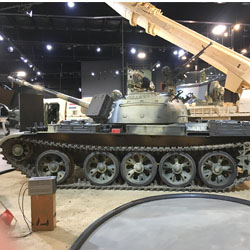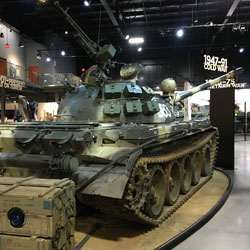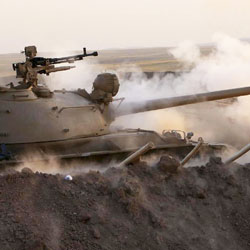The Russian T-54/55 is the most produced tank in military history. More thank 100,000 were manufactured as it served as the primary battle tank for the Soviet Union into the 1970s.
The first T-54 prototype was completed at Nizhny Tagil by the end of 1945. The T-54 eventually became the main tank for armored units of the Soviet Army, armies of the Warsaw Pact countries, and many others. T-54s and T-55s have been involved in many of the world’s armed conflicts since the later part of the 20th century.
The T-54/55 tanks are mechanically simple and robust. They are very simple to operate compared to Western tanks, and do not require a high level of training or education in their crew members. The T-54/55 is a relatively small main battle tank, presenting a smaller target for its opponents to hit. The tanks have good mobility thanks to their relatively light weight (which permits easy transport by rail or flatbed truck and allows crossing of lighter bridges), wide tracks (which give lower ground pressure and hence good mobility on soft ground), a good cold-weather start-up system and a snorkel that allows river crossings.
Production of the initial series of T-54s began slowly as many modifications were made in the prototype stage. The Red Army received a tank that was superior to World War II designs and theoretically better than the newest tanks of potential opponents. The 100 mm gun fired BR-412 series full-caliber APHE ammunition, which had superior penetration capability when compared to the T-34 that it replaced. The new dome-shaped turret with flat sides was inspired by the turret from the IS-3 heavy tank.
Trials with nuclear weapons showed that a T-54 could survive a 2–15 kt nuclear charge at a range of more than 980 feet from the epicenter, but the crew only had a chance of surviving at 2,300 feet. It was decided to create an NBC (nuclear, biological, and chemical) protection system which would start working 0.3 seconds after detecting gamma radiation. It was decided to increase the tank’s battle capabilities from earlier T-54 models by changing the tank’s construction and introducing new production technologies to make the T-55. Many of those changes were initially tested on the T-54M. The tank was fitted with the new V-55 12-cylinder 4-stroke one-chamber 38.88 liter water-cooled diesel engine developing 581 hp. The engine was to be started pneumatically with the use of an AK-150S charger and an electric starter. This eliminated the need for the tank to carry a tank filled with air. To allow easier access during maintenance and repairs, it was decided to change hatches over the engine compartment. To increase the operational range, 79 gallon fuel tanks were added to the front of the hull, increasing the overall fuel capacity to 180 gallons.
The T-54/55 and the T-62 were the two most common tanks in Soviet inventory—in the mid-1970s the two tank types together comprised approximately 85% of the Soviet Army’s tanks.
Soviet T-54 tanks served in combat during the Hungarian Revolution in 1956 and a few were successfully knocked out by the defending anti-Soviet Hungarian resistance-fighters and rebels using Molotov cocktails and several anti-tank guns. The local anti-communist revolutionaries delivered one captured T-54A to the British Embassy in Budapest. The analyses and studies of which helped and spurred the development of the Royal Ordnance L7 105 mm tank gun. At the initial stage of the war in Afghanistan in 1979-1980, about 800 Soviet tanks were used, consisting of 39 battalions, mainly armed T-54s and T-55s. In 1979, only one T-55 tank was lost. Since the beginning of 1980, they began to be replaced by modern T-62 and T-64 tanks.







